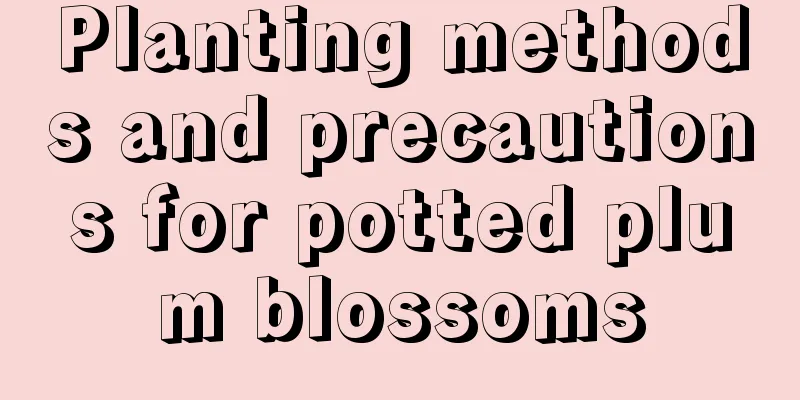Planting methods and precautions for potted plum blossoms

Planting methodPotted plum blossoms are mainly cultivated by grafting, with cutting grafting and bud grafting being the most common methods. The rootstock technique uses peach, wild peach or apricot. The bark of the old trunk of the apricot tree is red, and the bark of the grafted red plum flowers is harmonious in color. CuttingCutting grafting usually uses one or two year old rootstocks. At the end of March ( in a cold room ) or the beginning of April ( in the open field ) , the upper part of the rootstock is cut off 3-5 cm from the ground. The scion should be one-year-old strong branches, cut into 5-6 cm long, and leave at least 3 buds. The outer sides of the bottom bud are cut downward to form a duckbill shape. Open a 3 cm long joint on one side of the rootstock . Insert the scion into the cut of the rootstock so that the two form a close fit, and then tie it with plastic film tape. Or use polyester tape to stick it tight. Finally, cover the scion with a small plastic bag and tie the bag opening below the interface. You can check it frequently through the film. After the plant has grown back into life, remove the bindings. buddingBud grafting is carried out in August and September , and the " T " shaped grafting method is generally used . First, make a horizontal cut 1 to 1.5 cm above the scion bud , and then cut horizontally from 1 cm below the bud to the front and bottom. Gently peel off the wood inside the cortex of the cut bud ( in recent years, there are buds with slightly wood ) and put it in your mouth. Make a horizontal cut on the rootstock 5 cm from the soil surface , and then make a downward cut from the center of the cut to form a "丁" shape. Then gently peel off the cortex and insert the prepared scion into the cortex at the "丁" shape. The grafted bud should be firmly attached, with the upper end tightly combined with the upper end of the "丁" -shaped end of the rootstock, and finally tied with plastic film or polyester tape. Check the survival status after one week. If the petiole falls off when touched and the buds are green and plump, it means the plant has survived. In the spring of the following year , cut off the top of the rootstock 5-6 cm above the interface. The scion will sprout soon. Pay attention to cutting the rootstock buds later. When repotting or planting in pots, you can plant it deeper to lower the interface as much as possible. Tie it up according to its growth to form a beautiful shape. Preparation of potting soilMix 1/3 of rice husk ash with 2/3 of river mud, add human feces and urine, mix well, expose to the sun, and sieve for later use. Place tiles and stones at the bottom of the pot to facilitate drainage, then fill it with coarser soil, plant the plum tree, and bury the soil to compact the roots. Watering timeDo not water when potting; water once after 3 to 4 days; water once a day after 7 to 10 days; after it survives, water 1 to 2 times a day from May to August . The soil should not be too wet and waterlogging should be avoided. FertilizationPlum blossoms do not like heavy fertilizers. When the new shoots grow to about 5 cm, apply a thin layer of crushed bone sesame paste fertilizer water to promote the healthy growth of branches. When the leaves are released, there should be sufficient fertilizer and water. Generally, apply thin liquid fertilizer once a month to promote lush branches and leaves. When the branches grow to 20-25 cm, fertilizer and water should be applied sparingly. Apply top dressing twice in late summer and early autumn to promote flower bud differentiation. After each fertilization, you should pay attention to watering and loosening the soil in time to keep the soil in the pot loose, which is conducive to the development of the root system. Temperature, lightPlum blossoms prefer an environment with plenty of sunlight and good ventilation, and cannot tolerate long-term shade. Only by providing sufficient light and the conditions for photosynthesis can it obtain sufficient nutrition, and thus grow healthily and produce numerous large and bright flowers. |
<<: What is the reason for the succulent growth?
Recommend
The hydroponic method of Milan
Selecting plants If you want hydroponics, you mus...
Diseases and Pests of Phlox and Their Control
Diseases of Phlox Anthracnose of Phlox The most c...
Can orange trees be planted in the yard?
Can I grow an orange tree in my yard? Orange tree...
What to do if mint leaves turn yellow
Regular watering If the mint begins to wrinkle, t...
How to plant shallots and when is the best time to plant them?
Suitable time for planting shallots Scallions are...
What to do if peach beauty drops leaves
1. Caused by watering If your peach beauty starts...
What kind of plants are small shrubs?
1. What kind of plant is it? Small shrubs refer t...
What kind of fertilizer should be applied to castor bean base fertilizer? How to apply base fertilizer?
Castor bean base fertilizer effect Base fertilize...
When is the right time to sow rapeseed?
When is the best time to sow rapeseed? Rapeseed i...
How to keep Luanfengyu in winter
Lighting Management The Luan Feng Jade likes an e...
Why are the leaves of gardenia turning yellow?
1. Too much water Reason: Most plants will have m...
How to cultivate Fire Dragon Ball and what to pay attention to
The Fire Dragon Ball is a flower that grows very ...
How to breed the azure ring
Using the sowing method When propagating the gree...
What is the best month to plant roses?
Which month is suitable for planting roses? Roses...
Chlorophytum comosum and green radish… The reasons why flowers die in winter, you will regret it if you don’t read it
Pothos LVLUO Cause of death 1: Too little waterin...









